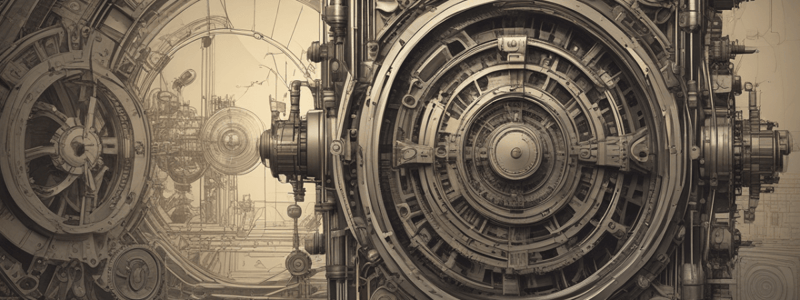Podcast
Questions and Answers
What is the definition of accuracy in mechanical engineering?
What is the definition of accuracy in mechanical engineering?
- The consistency of repeated measurements under unchanged conditions
- The smallest change in the measured quantity that the instrument can detect
- The closeness of the measured value to the true value (correct)
- The ratio of the change in the output signal to the change in the input quantity
What is the term for the smallest change in the measured quantity that the instrument can detect?
What is the term for the smallest change in the measured quantity that the instrument can detect?
- Sensitivity
- Linearity
- Resolution (correct)
- Precision
What is the importance of high precision in mechanical engineering?
What is the importance of high precision in mechanical engineering?
- To increase the sensitivity of the instrument
- To ensure reliable and consistent measurements (correct)
- To detect small changes in the measured quantity
- To ensure accurate measurements
What is the definition of sensitivity in mechanical engineering?
What is the definition of sensitivity in mechanical engineering?
What is the characteristic that ensures the instrument's response is predictable and straightforward to interpret?
What is the characteristic that ensures the instrument's response is predictable and straightforward to interpret?
What type of characteristics describe how measuring instruments behave under steady-state conditions?
What type of characteristics describe how measuring instruments behave under steady-state conditions?
What is the term for the consistency of repeated measurements under unchanged conditions?
What is the term for the consistency of repeated measurements under unchanged conditions?
Why is high accuracy essential in mechanical engineering?
Why is high accuracy essential in mechanical engineering?
What is the range of an instrument?
What is the range of an instrument?
What is hysteresis in the context of measurement instruments?
What is hysteresis in the context of measurement instruments?
What type of error is caused by human mistakes during measurement or recording?
What type of error is caused by human mistakes during measurement or recording?
What is the process by which errors in individual components affect the overall system error?
What is the process by which errors in individual components affect the overall system error?
What is the combination of errors in a measurement system?
What is the combination of errors in a measurement system?
What type of instrument is characterized by an instantaneous response to changes in the input?
What type of instrument is characterized by an instantaneous response to changes in the input?
What is the importance of understanding dynamic characteristics of measurement instruments?
What is the importance of understanding dynamic characteristics of measurement instruments?
What is the general mathematical model of a zero-order instrument?
What is the general mathematical model of a zero-order instrument?
What is the primary purpose of using telemetry systems in strain gauge measurement?
What is the primary purpose of using telemetry systems in strain gauge measurement?
What is a critical consideration when selecting a strain gauge for measurement?
What is a critical consideration when selecting a strain gauge for measurement?
What is the purpose of the Wheatstone bridge circuit in a strain gauge pressure cell?
What is the purpose of the Wheatstone bridge circuit in a strain gauge pressure cell?
What type of gauge is used to measure extremely high pressures in scientific research and industrial applications?
What type of gauge is used to measure extremely high pressures in scientific research and industrial applications?
What is the principle of operation of a McLeod gauge?
What is the principle of operation of a McLeod gauge?
What is the function of a diaphragm in a strain gauge pressure cell?
What is the function of a diaphragm in a strain gauge pressure cell?
What is a critical step in the installation process of strain gauges?
What is a critical step in the installation process of strain gauges?
What is the application of strain gauge pressure cells?
What is the application of strain gauge pressure cells?
What is the primary application of strain gauges in mechanical engineering?
What is the primary application of strain gauges in mechanical engineering?
What type of strain gauge is commonly made from constantan, nickel-chromium alloys, or similar materials?
What type of strain gauge is commonly made from constantan, nickel-chromium alloys, or similar materials?
What is the purpose of the calibration process in strain measurement?
What is the purpose of the calibration process in strain measurement?
What is the advantage of optical fiber strain gauges?
What is the advantage of optical fiber strain gauges?
What is the purpose of the dummy gauge method in temperature compensation?
What is the purpose of the dummy gauge method in temperature compensation?
What type of strain gauge circuit is simplest and least expensive but less sensitive?
What type of strain gauge circuit is simplest and least expensive but less sensitive?
What is the purpose of the calibration curve in strain measurement?
What is the purpose of the calibration curve in strain measurement?
What type of strain gauge is primarily used in pressure sensors?
What type of strain gauge is primarily used in pressure sensors?
What is the primary function of a manometer in pressure measurement?
What is the primary function of a manometer in pressure measurement?
Which of the following is a characteristic of a Knudsen Gauge?
Which of the following is a characteristic of a Knudsen Gauge?
What is the purpose of the electron source in an Ionization Gauge?
What is the purpose of the electron source in an Ionization Gauge?
What is the principle behind Thermal Conductivity Gauges?
What is the principle behind Thermal Conductivity Gauges?
What is the application of Pirani Gauges?
What is the application of Pirani Gauges?
What is the purpose of the porous plug in a Knudsen Gauge?
What is the purpose of the porous plug in a Knudsen Gauge?
What is the application of Ionization Gauges?
What is the application of Ionization Gauges?
What is the importance of understanding the principles and operations of pressure measurement methods?
What is the importance of understanding the principles and operations of pressure measurement methods?
Flashcards are hidden until you start studying
Study Notes
General Performance Characteristics of Measuring Instruments
- Static characteristics: describe the behavior of measuring instruments under steady-state conditions
- Accuracy: closeness of the measured value to the true value
- Precision: consistency of repeated measurements under unchanged conditions
- Resolution: smallest change in the measured quantity that the instrument can detect
- Sensitivity: ratio of the change in the output signal to the change in the input quantity
- Linearity: degree to which the output signal is directly proportional to the input quantity
- Range: minimum and maximum limits within which the instrument can accurately measure the input quantity
- Hysteresis: difference in output when the input quantity is increased and then decreased
- Types of errors: errors that can arise in measurements
- Gross errors: human errors or mistakes during measurement or recording
- Systematic errors: consistent, predictable errors that can often be corrected
- Instrumental errors: due to imperfections or miscalibration of the instrument
- Environmental errors: caused by external conditions like temperature, humidity, and pressure
- Observational errors: errors due to the observer, such as parallax errors
- Random errors: unpredictable variations in the measurement process that cannot be easily corrected
- Combination of component errors: errors in individual components can propagate and affect the overall accuracy of a measurement system
Dynamic Characteristics of Instruments
- Dynamic characteristics: describe how an instrument responds to changes in the measured variable over time
- General mathematical models: used to describe the behavior of zero-order, first-order, and second-order instruments
- Response to different inputs: instruments can respond to various inputs, including step, ramp, impulse, and frequency
- Zero-order instruments: characterized by an instantaneous response to changes in the input
- First-order instruments: characterized by a response that changes over time
- Second-order instruments: characterized by a response that changes over time and is influenced by damping and natural frequency
Strain Measurement
- Strain gauges: used to measure strain on various structures
- Types of strain gauges:
- Metallic foil strain gauges: most common type, consisting of a grid of thin metallic foil bonded to an insulating backing material
- Semiconductor strain gauges: made from silicon or germanium, higher sensitivity but more temperature-sensitive
- Bonded and unbonded strain gauges: differ in how they are attached to the test specimen
- Optical fiber strain gauges: use changes in light transmission to measure strain
- Piezoresistive strain gauges: used in pressure sensors, utilize the change in electrical resistance of a piezoresistive material
- Strain gauge circuits:
- Quarter-bridge circuit: simplest and least expensive, uses a single active strain gauge and three fixed resistors
- Half-bridge circuit: uses two strain gauges, can measure bending strains and provide some temperature compensation
- Full-bridge circuit: uses four strain gauges, provides maximum sensitivity and temperature compensation
- Calibration: process of ensuring accurate strain measurements
- Applying known loads: apply known mechanical loads or strains to the test specimen and record the corresponding electrical output
- Generating calibration curve: plot the known loads against the electrical output to create a calibration curve
- Deriving calibration factor: calculate the calibration factor, which relates the electrical output to the actual strain
- Temperature compensation: methods to compensate for temperature changes that can affect strain gauge readings
- Using temperature-compensated strain gauges: gauges designed with materials having matching thermal expansion coefficients
- Dummy gauge method: uses a non-stressed dummy gauge in the same thermal environment as the active gauge
- Quarter-bridge temperature compensation: uses an additional strain gauge in the bridge that is not subject to strain but experiences the same temperature changes
- Use of strain gauges on rotating shafts: special considerations for using strain gauges on rotating shafts
- Wireless data transmission: use telemetry systems to transmit strain data wirelessly from the rotating shaft to a stationary data acquisition system
- Slip rings: use slip rings to maintain electrical connections between the rotating strain gauge and the stationary measurement equipment
- Careful installation: ensure strain gauges are securely bonded and the wiring is protected against centrifugal forces
- Selection and installation of strain gauges: critical for obtaining accurate and reliable strain measurements
- Selection criteria: strain range, gauge factor, environmental conditions, and material compatibility
- Installation process: surface preparation, bonding, wiring, and protection
Pressure Measurement
- Basic methods of pressure measurement:
- Strain gauge pressure cell: uses the deformation of a diaphragm or other elastic element under pressure to measure strain
- High pressure measurement: uses the Bridgeman type gauge, which measures high pressures by using the change in electrical resistance of a wire or material under pressure
- Low pressure measurement: uses various methods, including McLeod, Knudsen, ionization, and thermal conductivity gauges
- Strain gauge pressure cell: components and operation
- Diaphragm: a flexible membrane that deforms under pressure
- Strain gauges: bonded to the diaphragm to measure deformation
- Wheatstone bridge circuit: converts the strain gauge resistance changes into a measurable voltage output
- High pressure measurement - Bridgeman type gauge: principle, components, and operation
- Principle: measures high pressures by using the change in electrical resistance of a wire or material under pressure
- Components: pressure vessel, wire or material, and electrical circuit
- Operation: measures the change in resistance of the wire or material under pressure
- Low pressure measurement methods:
- McLeod gauge: measures low pressures by compressing a known volume of gas and measuring the resulting increase in pressure
- Knudsen gauge: measures pressure based on the thermal transpiration effect, where gas molecules flow through a porous plug due to a temperature gradient
- Ionization gauge: measures very low pressures by ionizing the gas and measuring the resulting ion current
- Thermal conductivity gauges: measures pressure based on the thermal conductivity of the gas, which varies with pressure
Studying That Suits You
Use AI to generate personalized quizzes and flashcards to suit your learning preferences.





